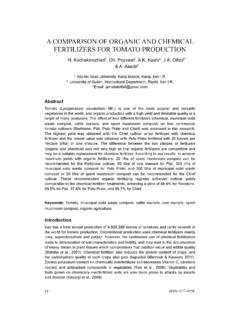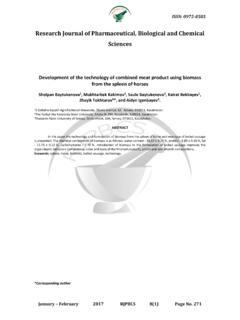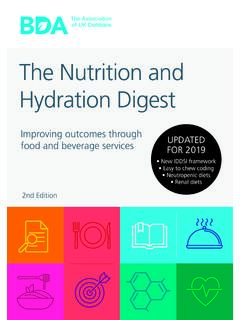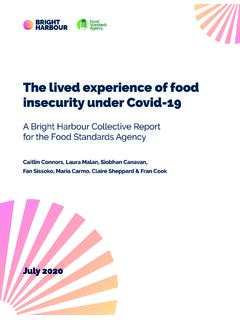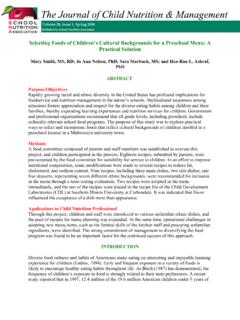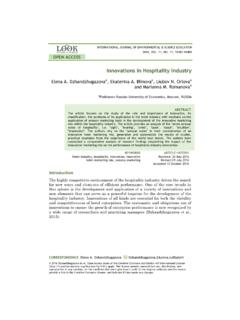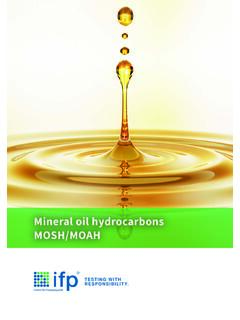Transcription of The effect of organic fertilizers on growth and yield of ...
1 ISSN 1177-4258 9 Journal of organic Systems, 10(1), 2015 ORIGINAL PAPER The effect of organic fertilizers on growth and yield of broccoli (Brassica oleracea L. var. italica Plenck cv. Top Green) Jigme1*, Nipon Jayamangkala1, Pathipan Sutigoolabud2, Jirapon Inthasan2 and Siriwat Sakhonwasee1 1 Department of Horticulture, Faculty of Agriculture Production, Maejo University, Chiang Mai, Thailand 2 Department of Soil Science, Faculty of Agriculture Production, Maejo University, Chiang Mai, Thailand * Corresponding author: Abstract The research was undertaken to study the effect of application of different rate of organic fertilizers on broccoli. There were five treatments in total consisting of inorganic, organic fertilizers and blank control. The organic treatment included compost applied with three different rates of chicken manure tea (CMT) (0 ml/week, 100 ml/week and 200 ml/week) and the remaining two treatments were inorganic fertilizer treatment and blank control.
2 The vegetative parameters measured were stem diameter, leaf number, leaf diameter, plant weight and height. In all the vegetative parameters measured, the inorganic fertilizer treatment gave the highest mean value which was statistically significantly different from other treatments except for leaf diameter which was statistically similar to CMT 200 ml and compost treatment. The result showed that the head yield of inorganic fertilizer was statistically highly significant over organic treatments, but there was no significant difference between inorganic fertilizers and 200ml CMT/week and compost treatments. The highest yield was obtained from inorganic fertilizer with the yield of t/ha and the least from control with yield of t/ha respectively. The positive dose-response pattern of the CMT applications suggests that there is good potential to further optimise this soil amendment.
3 Also, an economic analysis of the costs and benefits of the high performing organic treatments would be valuable. Keywords: chicken manure tea; yield ; broccoli; organic ; inorganic. Introduction Growing organic vegetable is a rapidly growing industry and the concerns over the pesticides residues in food and the environment has resulted to increase in demand for organic food. Organically grown foods are perceived as better quality, healthier and more nutritious than conventional counterparts (Warman and Havard, 1997). On the other hand, the relatively slow mineralization of the composts and other organic fertilizers limits the effective nitrogen utilization (Hartz et. al., 2000). The low availability of nitrogen in organic fertilizers is the main underlying factor contributing to the low yield in organic farming and as per Badgley et.
4 Al. (2007) The principal objections to the proposition that organic agriculture can contribute significantly to the global food supply are low yields and insufficient quantities of organically acceptable fertilizers . However, liquid organic fertilizers like poultry manure tea and compost tea have been found to contain nitrogen mainly in inorganic form like ammonia (Price and Duddles, 1984; Gross et al., 2007) and can provide nutrients instantly to the plants much like the chemical fertilizers . Not much information is available on fertigation of crops by manure teas. Broccoli (Brassica oleracea italica) belongs to family Brassicaceae. It is a fast growing crop and requires high nitrogen input. It is one of the most important crops as it is highly nutritious vegetable with abundant vitamins and minerals such as vitamin A and C, carotenoids, fiber, calcium, and folic acid (Paradis, et al.)
5 1995; Michaud et. al., 2002). Broccoli and other brassica vegetables have high content of glucosinolates (Zhao et al., 2007) which has cancer-fighting properties. Broccoli buds are rich source of minerals especially K, S, P, Mg and micro-elements (Aboul-Nasr and Ragab, 2000). The aim of this investigation was to evaluate the productivity of broccoli with organic fertilizers and compare with mineral fertilizing. Jigme et al. Journal of organic Systems, 10(1), 2015 ISSN 1177-4258 10 Methodology The study was conducted under field conditions in the research field of the Vegetable Division, Maejo University, Thailand. Before planting, soil samples consisting of approximately ten cores across the diagonal of the soil layers 0 30 cm deep of the experimental field were taken to determine the amount of NPK and other experiment was laid out in randomized complete block design (RCBD) and the treatments were replicated three times.
6 Broccoli (Broccoli oleraceae L. var. italica) cultivar Top Green was cultivated as the experiment plant. The broccoli seeds were sown in plastic nursery trays filled with peat as the growing media and raised inside greenhouse. After one month, the seedlings were transplanted in the field at a spacing of 60 cm (row) by 40 cm (plant) on raised beds. The compost was prepared by Passively Aerated Window Method (FAO, 2003).The C/N ratio of the raw materials was maintained at 1:30. The compost mixture was placed inside heavy duty polythene bag having a dimension of 2 m in height and m wide. One perforated plastic pipes, each having four rows of cm (FAO, 2003) diameter holes drilled in it, was inserted into the compost bag for aeration. The mouth of the bag was closed and the upper ends of the inserted pipes were exposed to the open air to facilitate aeration in the interior of the compost pile.
7 The composting was carried for one month and then cured for additional one month. The chicken manure tea (CMT) was prepared by Bucket Method as described by Ingham (2005). A total of twenty kg fresh poultry manure was collected every week from the Maejo University Dairy Farm. The manure was then put in a burlap sack, tied with string and placed in the bucket without it touching the floor with the help of horizontally placed sticks. Then twenty litres of de-chlorinated water (1:1 W/V) was added into the bucket. As a food source for beneficial microorganisms during fermentation period, one litre of molasses were added. The lid of the bucket was partially closed and stirred twice (once each in the morning and evening) daily and after fifteen days, the tea was steeped and used in the experiment plot.
8 Treatments There were five treatments in total, 1. Compost, 2. Compost and chicken manure tea (100 ml/week), 3. Compost and chicken manure tea (200 ml/week), 4. Inorganic fertilizers , and 5. Control (without fertilizers ). The compost at the rate of 100 g/m2 was mixed with the soil during the bed preparation in all the organic plots. The chicken manure tea was applied on weekly basis starting from the day of transplanting at the rate of 0 ml/m2, 100 ml/m2 and 200 ml/ m2 in treatment , 2 and 3 respectively. The mineral fertilizers were applied at the rate of g urea, g P205 and g K20 per meter square as per the soil analysis report and the recommendation of the Oregon State University (2004). Measurements Vegetative growth characteristics were measured on a random sample of ten plants, taken from each experimental bed and the following data were recorded: plant height, leaf number per plant, stem diameter, leaf diameter and plant weight.
9 All broccoli heads of each plot were harvested at marketable stage and the following variables measured: head yield (t/ha), mean head weight (g/plant), head diameter (cm), and head compactness (head diameter/head weight in grams). Statistical analysis The data collected in the experiment were statistically analysed with SAS Version statistical software program. Analysis of variance (ANOVA) was done on every measured parameter to determine the significance of differences between means of treatments. Means for each parameter were separated by the least significant difference (LSD) test at P Results 1. Nutrient content in composts and chicken manure tea The Table 1 shows the nutrient composition of compost, chicken manure tea, soil in organic plot and in inorganic plot. Composts were analysed for its nutrient content after 68 days of composting.
10 Chicken manure tea (CMT) was analysed after fermenting for 14 days. It has already been established by Rai (2010) that the 15 days old CMT had the higher nitrogen content over the one that was fermented for 21 days. According to Gross et al. (2008), all the uric acid in the chicken manure is degraded to ammonium by this period and it will just result in loss of ammonium through Jigme et al. Journal of organic Systems, 10(1), 2015 ISSN 1177-4258 11 ammonification. A similar method was used to prepare the tea and only the 14 days old sample were analysed for nutrient content. The CMT had an NPK content of , and respectively, with a pH of Table 1. Nutrient content in composts and chicken manure tea. organic fertiliser treatment pH Nitrogen (%) Phosphorus (%) Potassium (%) Carbon (%) C:N ratio Compost Chicken manure tea organic plot Inorganic plot 2.



